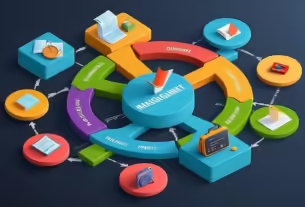What is One Way That Technology Can Improve the Distribution of Goods? – In the world of instant gratification, distribution plays a crucial role in maintaining business and consumer connections. However, outdated methods can cause delays, increase costs, and frustrate customers. Many wondered why online orders take longer than expected or certain products seem out of stock.
The Problem: Inefficiencies in Goods Distribution
The National Retail Federation highlights the high cost of stockouts and overstocks due to outdated technology in traditional distribution systems. These issues can lead to stockouts and excess inventory, causing businesses to struggle with efficient reordering.
Manual inventory management is slow and prone to errors, resulting in incorrect shipments, returns, and customer dissatisfaction. The Aberdeen Group reports that companies using manual systems experience a 30% longer order cycle time than those using automated solutions.
Additionally, inaccurate data can lead to running out of items or excess inventory, tying up capital and increasing storage costs. The Harvard Business Review suggests that businesses with precise forecasting can see up to a 10% increase in profitability.
The Agitation: The Ripple Effect of Distribution Problems
Delivery delays can lead to frustration and erode trust in a company. Inefficient inventory management costs the grocery sector $2.4 billion annually, and repeated delivery issues or stockouts can damage a company’s reputation.
Negative reviews and poor customer experiences can deter future customers, impacting overall business growth. Additionally, companies may face increased costs due to expedited shipping or additional handling to fix errors, which can erode profit margins and affect financial stability.
Therefore, companies must prioritize efficient inventory management and customer satisfaction to maintain a competitive edge.

The solution: leveraging technology for efficient distribution
Automated warehouse management systems (WMS) are a powerful solution to distribution problems. These systems offer real-time inventory tracking, allowing businesses to maintain accurate stock counts and manage inventory more effectively.
Oracle, a leading retailer, reported a 30% reduction in stockouts and a 25% improvement in order accuracy. Smart forecasting using data analytics and algorithms reduces the risk of overstocking or stockouts, with McKinsey & Company finding a 10-15% improvement in inventory turnover rates.
WMS can automatically reorder products when stock levels fall below a certain threshold, ensuring timely replenishment. Walmart, for example, maintains a high inventory turnover ratio. Automated WMS streamline operations, reduce manual errors, and speed up processes.
Aberdeen Group research shows a 20% reduction in inventory carrying costs and a 15% reduction in stockouts. Efficient inventory management also improves customer satisfaction, as 78% of consumers expect a seamless shopping experience.
Case Study: Transforming Distribution with Automated WMS
An automated WMS has significantly improved the efficiency of a small e-commerce business by enhancing order fulfillment. The system used advanced algorithms to optimize picking routes, reducing time spent on product placement and speeding up order processing.
It also reduced packaging errors by providing real-time guidance to warehouse staff, ensuring correct items were picked and packed. Customers received accurate, real-time order updates, enhancing transparency and trust.
The streamlined system reduced the need for manual intervention, allowing the business to handle higher order volumes more efficiently. This resulted in increased customer satisfaction, sales, and overall growth for the business.
The Role of IoT and Real-Time Tracking
WMS and real-time data from GPS devices play a crucial role in improving distribution. These technologies provide enhanced visibility, enabling businesses to monitor and manage their supply chain more effectively.
Advanced algorithms analyze real-time data to determine efficient delivery routes, reducing fuel consumption and travel time. Additionally, IoT sensors monitor temperature-sensitive goods, ensuring optimal conditions for optimal transport and maintaining product quality and safety. These technologies enhance visibility, optimize routes, and enhance supply chain management.
Case Study: IoT in Action
The company implemented IoT devices to track shipments, resulting in cost savings and improved customer satisfaction. Real-time tracking helped identify potential delays before they affected delivery schedules.
Accurate updates on shipment status increased trust and satisfaction. Optimized delivery routes and reduced delays resulted in significant cost savings. Continuous monitoring of temperature-sensitive shipments ensured they remained within the required range. These advancements improved distribution efficiency and bolstered the company’s reputation as a reliable logistics provider.

The Future of Distribution: Embracing Technology
Artificial intelligence (AI) and blockchain technology are revolutionizing the distribution industry. AI can predict demand, optimize inventory levels, and enhance efficiency, leading to reduced costs and improved operations.
Robots can automate repetitive tasks, reducing manual labor and errors. Blockchain technology provides a secure, transparent way to track goods, enhancing trust and reducing fraud. Drones and autonomous vehicles can revolutionize last-mile delivery by reducing delivery times and costs, especially in remote areas. As technology evolves, businesses must adapt to meet modern consumer demands and stay ahead of the competition.
Conclusion: Embrace the Future
In conclusion, technology has the power to revolutionize the distribution of goods, making it more efficient, reliable, and cost-effective. By implementing automated warehouse management systems, leveraging IoT and real-time tracking, and embracing emerging technologies like AI, robotics, blockchain, and drones, businesses can overcome the challenges of traditional distribution methods.
The future of distribution is in the hands of those who are ready to adopt and harness the potential of technology. Doing so not only helps meet the demands of modern consumers but also drives growth, enhances customer satisfaction, and keeps businesses competitive. The time to act is now—embrace the future of distribution and unlock the full potential of technology.
Frequently Asked Questions
1. What are common issues with traditional distribution methods?
Answer: Traditional methods often face stockouts, overstocks, and error-prone manual processes, leading to delays, higher costs, and customer dissatisfaction.
2. How does an automated warehouse management system (WMS) help?
Answer: Automated WMS improves distribution by tracking inventory in real time, optimizing picking routes, and reducing manual errors.
3. What is the role of the Internet of Things (IoT) in distribution?
Answer: IoT provides real-time tracking and monitoring of shipments, ensuring timely deliveries and maintaining product quality.
4. Can you give an example of successful technology use in distribution?
Answer: Walmart uses automated WMS to efficiently manage inventory and reduce stockouts. A logistics company using IoT devices saw reduced delays and cost savings.
5. What emerging technologies could enhance distribution?
Answer: AI, robotics, blockchain, and drones are set to improve demand forecasting, automate tasks, ensure transparency, and speed up deliveries.
6. How does technology reduce distribution costs?
Answer: Technology reduces costs by improving efficiency, optimizing routes, and minimizing inventory errors and excess.
7. What are the benefits of real-time tracking for customers?
Answer: Real-time tracking provides accurate updates on order status, enhancing transparency and customer satisfaction.
8. What challenges do businesses face when adopting new technologies?
Answer: Challenges include high initial costs, system integration, and the need for staff training.
9. How can small businesses use technology for distribution?
Answer: Small businesses can use cloud-based WMS and affordable IoT devices to optimize inventory and improve order fulfillment.
10. Why should businesses keep up with technological advancements?
Answer: Keeping up with technology helps businesses stay competitive, improve efficiency, and meet evolving customer demands.



